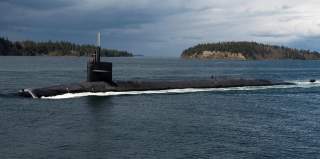It Was Bloody: How the U.S. Navy's Submarines Became the Best on the Planet
It took one truly terrible accident.
What sank Thresher? The best available theory is the extensive use of silver brazing on piping throughout the ship.
In the United States Navy, submarines lost at sea are said to be on “eternal patrol.” One such submarine was USS Thresher. Meant to be the first in a new generation of fast nuclear-attack submarines, today it rests in more than eight thousand feet of water, along with its crew. Thresher is one of two American submarines lost since the end of World War II.
In the mid-1950s, the U.S. Navy was still pushing nuclear propulsion out to the submarine fleet. USS Nautilus, the world’s first nuclear submarine, had just been commissioned in 1954, and nine classes of submarines were created, including the Sailfish, Barbel, Skate and Skipjack classes, before the Navy felt it had a design worthy of mass production. Preceding classes of nuclear submarines were built in small batches, but Thresher would be the first class to build more than five. Altogether fourteen Threshers would be built.
The Threshers were designed to be fast, deep-diving nuclear attack submarines. They were the second class, after the pioneering Skipjack class, designed with the new streamlined hull still in use today. They were the first submarines to use high strength HY-80 steel alloy, which was used through the 1980s on the Los Angeles class.
The submarines were just 278 feet long, with a beam of thirty-one feet. They weighed 4,369 tons submerged, making them about 30 percent larger than the Skipjacks. Their S5W pressurized water reactor drove two steam turbines, which turned a single propeller to a combined thirty-thousand-shaft horsepower. This gave them a surface speed of twenty knots, and thirty knots submerged. This was a noticeable improvement over the underwater speed of the older Skate class, which could manage only twenty-two knots underwater.
The ship primary sensor was a BQQ-2 bow-mounted sonar, the first bow-mounted sonar in any American attack submarine. This necessitated moving the four torpedo tubes amidships, an arrangement that is carried on to this day in the Virginia-class subs. The submarines could carry Mark 37 homing torpedoes, Mark 57 deep-water mines, Mark 60 CAPTOR mines and the SUBROC antisubmarine weapon. The Thresher would be a powerful addition to the U.S. Navy’s submarine fleet.
On April 9th, 1963, USS Thresher was conducting dive tests 220 miles east of Cape Cod. Though it had been in service for two years, the U.S. Navy was still attempting to determine the true strength of its hull. At the time of the incident it was reportedly at a test depth of 1,300 feet, with the submarine rescue ship USS Skylark waiting above. Onboard were its standard complement of sixteen officers and ninety-six enlisted, plus seventeen civilian contractors on board to observe the tests.
At 9:13 a.m., fifteen minutes after reaching test depth, Thresher reported to Skylark, “Experiencing minor difficulties. Have positive up angle. Am attempting to blow [ballast tanks]. Will keep you informed.” Two more garbled messages followed, then a sound “like air rushing into an air tank.” Thresher was never heard from again. Its hull was found at the bottom of the ocean, under a mile and a half of water, ruptured into six pieces.
What sank Thresher? The best available theory is the extensive use of silver brazing on piping throughout the ship. An estimated three thousand silver-brazed joints were present on the ship, and the theory goes that up to four hundred of them had been improperly made. Experts believe that a pipe carrying seawater experienced joint failure in the aft engine spaces, shorting out one of the main electrical bus boards and causing a loss of power.
But a loss of electrical power was only half of the problem. According to Navy testimony provided in 2003 to the House Science Committee, the crew was unable to access vital equipment to stop the flooding. As the submarine took on water, the ballast tanks failed to operate. Investigators believe restrictions on the air system and excessive moisture in the air system led to a buildup of ice in the ballast valves, preventing them from being blown and counteracting the effects of the flooding.
The U.S. Navy immediately moved to prevent such as tragedy from happening again. Less than two months later it created SUBSAFE, a program designed to ensure the structural integrity of submarine hulls at pressure and, if an emergency occurred, ensure that the submarine could safely surface. It established submarine design requirements and certified construction procedures “as specific as cataloging the source of alloy for each piece of equipment that is SUBSAFE approved.”
The creation of SUBSAFE lead directly to tougher—and safer—submarines. (Another U.S. Navy submarine, Scorpion, was lost in 1968 but there is no conclusive explanation for the sinking.) In 2005, the USS San Francisco collided with a seamount at maximum speed—an estimated thirty miles an hour at a depth of 525 feet. SUBSAFE’s careful watch over submarine design and manufacture is credited with ensuring the San Francisco not only failed to sink, but that only one sailor died and the ship could even make it back to Guam on its own power. Although the loss of Thresher to eternal patrol was a painful one, the reforms undertaken by the Navy ensured the 129 lives lost would not be in vain.
Kyle Mizokami is a defense and national security writer based in San Francisco who has appeared in the Diplomat, Foreign Policy, War is Boring and the Daily Beast. In 2009 he cofounded the defense and security blog Japan Security Watch. You can follow him on Twitter: @KyleMizokami.
Image: Department of Defense.
This first appeared in 2016 and is being reposted due to reader interest.

